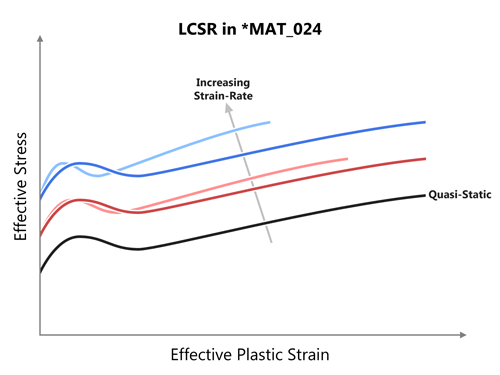The widely popular material model *MAT_PIECEWISE_LINEAR_PLASTICITY (MAT_024) supports various methods to include the strain-rate effects. One of the methods is the scaling of the quasi-static stress-strain curves using a load-curve, LCSR, that defines a scale-factor as a function of strain-rate. This method works by first finding the yield-stress, SIG_QUASI_STATIC, as a function of the effective plastic strain, that may be defined using a load curve LCSS or using discrete points using ES-EPS, and then multiplies this value by the scale-factor by looking up the curve LSCR to give a ‘scaled’ yield stress, SIG_SCALED. Plasticity of the material is then determined by comparing the trial stresses with the scaled stress, SIG_SCALED. If the trial stress is greater than SIG_SCALED, then the plastic strain increment is computed and the trial stress is scaled back to the yield surface using the radial-return algorithm. The primary limitation of this method is in its assumption that the stress-strain curves at higher strain-rates is a simply y-scaling of the quasi-static curves which is not the case in many materials. It is well known that at higher strain-rates, the materials not only show an increase in the yield strength but they also exhibit brittleness that is not captured by the LCSR method. This is graphically demonstrated in the figure below. The black curve is the quasi-static curve that can be input using either EPS-EPSS or LCSS parameters. The dark colored curves, red and blue, show the scaled curves as a function of strain-rates using the LCSR parameters. The lighter counterparts of red and blue curves show the actual behavior that is often seen in the physical tests where some amount of brittleness is observed.















